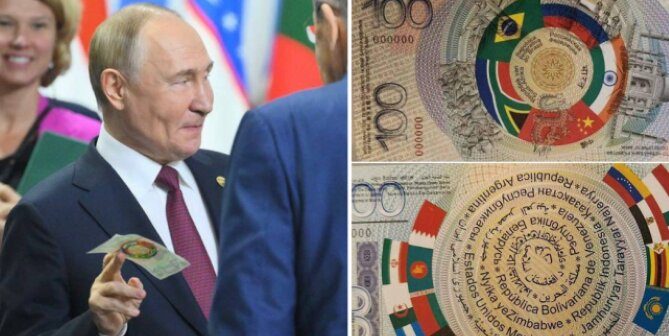In a historic move at the recent BRICS summit in Kazan, Russia, leaders from Brazil, Russia, India, China, and South Africa introduced a symbolic BRICS banknote as part of their ambitious initiative to promote trade in local currencies, reducing dependency on the US dollar. This banknote, featuring the flags of the member nations, symbolizes the bloc’s dedication to developing a multi-currency system that can strengthen economic sovereignty and offer alternatives to dollar-based financial systems.
This development underscores the bloc’s goal to create a new global financial architecture through mechanisms that support local currency transactions among member states. Russia has proposed establishing a “BRICS Bridge” payment system, which would work similarly to the global SWIFT network and enable direct trade settlements in local currencies. Additionally, they are exploring the use of digital ledger technologies (DLTs) and tokens to simplify transactions, potentially reducing compliance costs and bypassing challenges such as economic sanctions. By shifting away from the dollar, BRICS aims to enhance economic security for its member countries, saving an estimated $15 billion annually through local currency trade.
The expansion of BRICS in January 2024 to include Iran, the United Arab Emirates, Ethiopia, and Egypt has further intensified this push for a de-dollarized global economy. With over 30 nations expressing interest in joining BRICS, the bloc’s potential influence on global trade and finance is substantial. Current data shows that around 54% of global foreign trade invoicing and 58% of international payments still rely on the US dollar, highlighting the challenge BRICS faces in reshaping the established financial order.
In addition to the payment system, the New Development Bank (NDB), established in 2015 by BRICS, plays a pivotal role in supporting this transition. The NDB facilitates lending in local currencies and has welcomed new members, including the UAE, Bangladesh, Uruguay, and Egypt, reinforcing its commitment to financing sustainable development and promoting local currencies. Moving forward, BRICS aims to establish new guidelines for member expansion, focusing on shared economic and political values to shape a more balanced global economy.
Ultimately, this initiative marks a significant step in BRICS’ journey toward creating a multipolar financial landscape, with the NDB and BRICS Bridge payment system laying the foundation for increased local currency usage. As the bloc continues to implement these measures, it hopes to reduce dependency on the dollar, promote financial inclusivity, and inspire developing countries worldwide to pursue similar paths to economic independence. This symbolic banknote, while not yet a fully operational currency, underscores the bloc’s intent to redefine global trade dynamics and foster a more diverse economic ecosystem.






